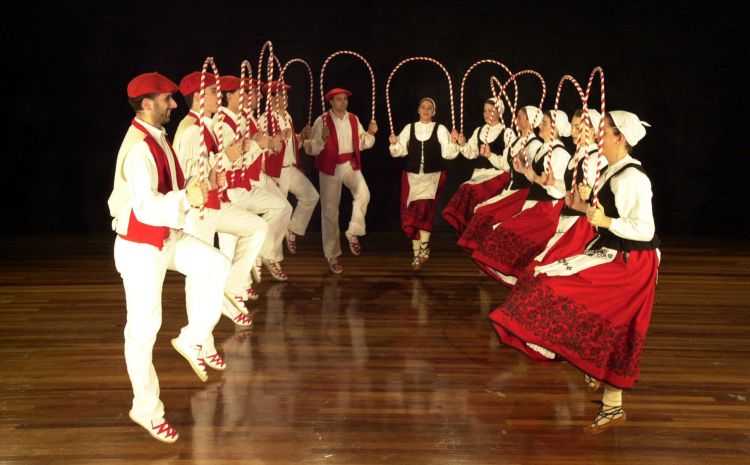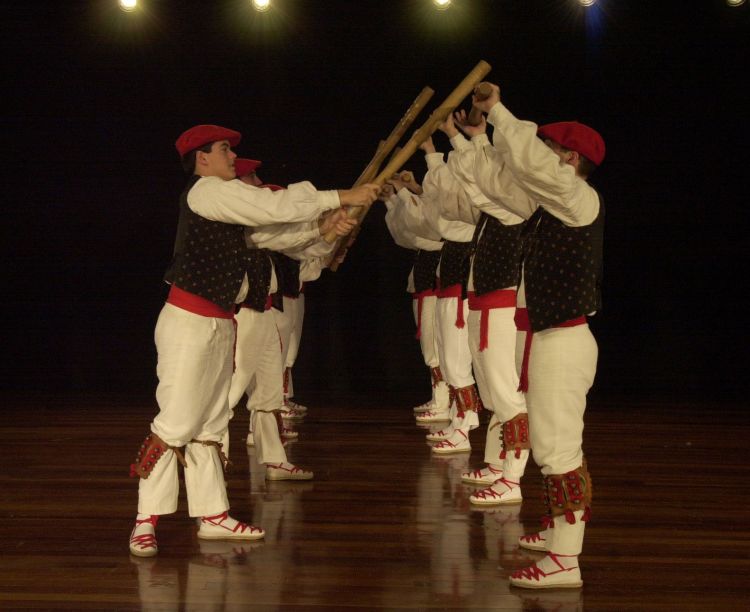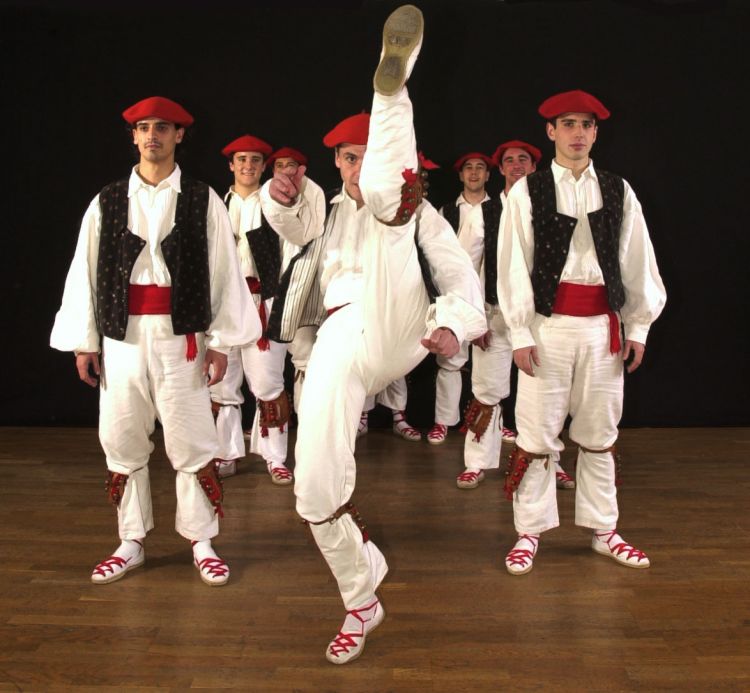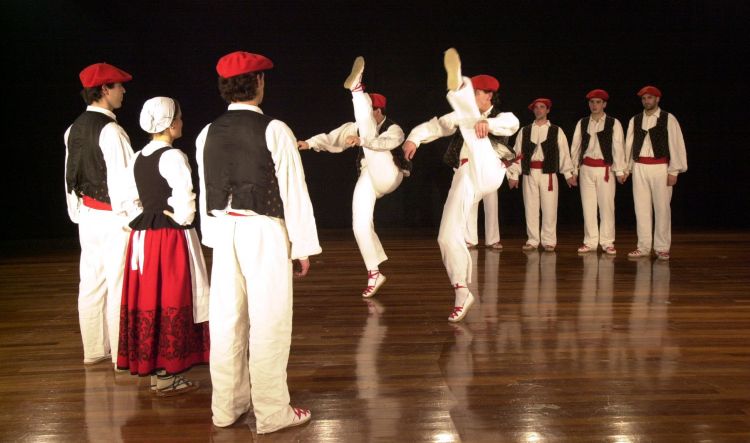Lanestosako Uztai Dantza
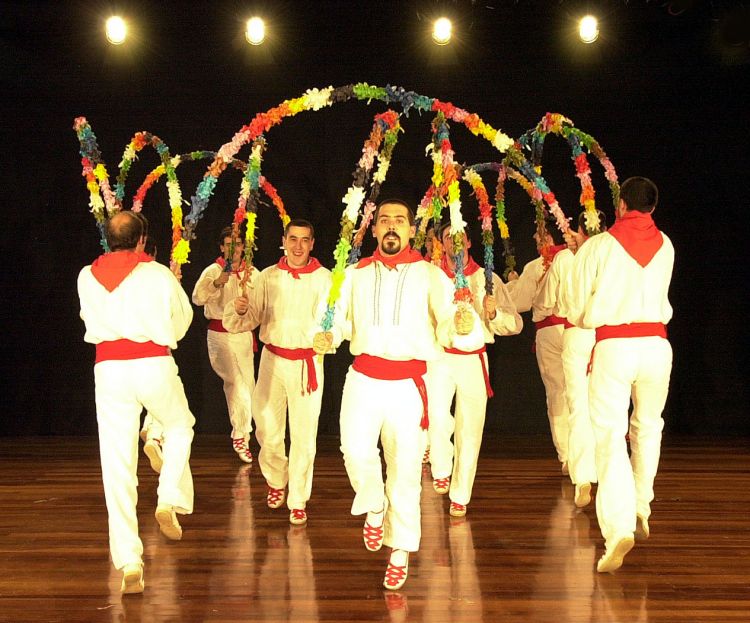
The most complete and detailed study we have of the dances and customs of the geographical area of Lanestosa was written by Emilio Xabier DUEÑAS (see attached article). The author shows that the arch dance of Lanestosa, which accompanies the procession honouring the Virgin, contains its own hierarchy. The order is as follows: The altar boy bearing the cross; the dancers and musicians; the image of the Virgin; the priests; the public authorities; the child dancers; and finally the general populace. There are no other rituals aside from the procession itself that might suggest that the dance should be interpreted as anything but a rogation.
The dance is one of the type performed by a compact group of men (sometimes married, in which case the knot in their scarves is adorned with a wedding ring), who perform sequences that are similar seen in other dances involving weapons, specifically those involving the "pennant sword". In this case, though, the entourage of dancers is delimited by the arch linking the hindmost dancers, whereas in the case of sword dances, they generally leave a gap, allowing other dancers to join in, even if it hinders the performance.
The figure of a dance master, or more specifically, a "captain" in the group is also common in representations of pastoral groupings, where the role is played by the head shepherd. We might take it, then, that these dances pertain to societies involved in highland livestock farming, and indeed, this is still the main livelihood of the region today.
Clothing

Researchers generally agree that the dancers wore white espadrilles with interwoven red ribbons, and white socks, trousers and shirts, with no special decoration, They also wore red gerrikoak or sashes in the local style. They never wore berets (txapelak), however, but instead had knotted red scarves on their heads. They also wore another scarf, which was sometimes fastened with the dancer's wedding ring. Otherwise the outfit seems not to have changed.
Implements
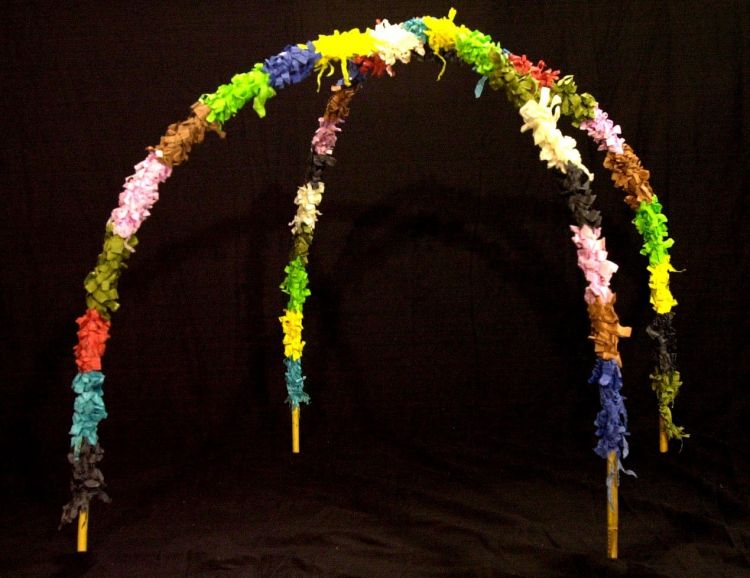
Apart from the Soka Dantza, the Jota or Fandango and the Arin Arin and the final Biribilketa, arches are used in all the dances of Lanestosa.
Music
We have references to the drum as being the first musical instrument to be used. Other instruments appear to have been added later, depending on what musicians could add to the dance; And so we find flageolets, fifes, timbrels, different types of pipes, from Galician bagpipes, to the "dulzaina" or sweet pipe, and, finally, the txistu, accompanied by the timbrel and tabor.
History and Geography
Lanestosa is the most westerly town in the province of Bizkaia, and lies on the border with the province of Santander in the Autonomous Community of Cantabria. Indeed, it is entirely surrounded by Cantabrian lands, except for the hills of Carranza (Karrantza), which also belong to Bizkaia. It is the smallest village in the province and stands between the hill and the river that mark the boundaries between the two regions. In the past, this led to numerous legal battles over boundaries and pastureland, as attempts at expansion for administrative reasons.
Iñaki IRIGOYEN has found the first written reference to the payment of musicians, dating from 1651, although this document does not clearly define the type of dances that were performed. The reference is to the feast day of St. Francis, which is no longer celebrated in the area. During the eighteenth century, the researcher continues, bagpipes - probably of Galician origin - were played at the town's main fiestas, since the municipal musician was a skilled pipe player. In the nineteenth century its place had been taken by the (Biscayan?) dulzaina (an instrument similar to a clarinet), which was in turn replaced by the "txistu".
The first direct references to the dances of Lanestosa found by the writer date back to 1727, and speak of the dances performed during the Corpus Christi festivity and at during the fiestas of Our Lady of the Snows, as well as rogative dances for good weather.
The celebration of the feast day of Our Lady appears to have survived intact from the eighteenth century down to the present day, when it is still performed. There are indications of a prehistoric population. In caves in the immediate surroundings of the town - in both Cantabria and Bizkaia - there is evidence of paleolithic habitation by small groups of hunter-gatherers. Nearby there are also caves with paintings of the animals that formerly inhabited the region, from reindeers to wild boar. One may therefore conjecture that there may have been regular settlement throughout the prehistoric period.
At a later period, the local population was quickly Romanised, and the disappearance of place names in the Basque language shows how firmly the new culture must was adopted. During the thirteenth century the town became part of Bizkaia. From that point on, its history is inextricably linked to that of the Encartaciones area.
Towards the end of the sixteenth century the area was ravaged by the plague, and there were prayers, processions and votive acts to try to prevent the disease from spreading amongst the local inhabitants. It was during this period that a trade route for wool and other items developed between the high plateau and the port of Laredo, passing through Lanestosa. The town grew thanks to its natural position on the way from Burgos and Carranza to the sea.
However, the rivalries between Bilbao, on the one hand, and Castro, Laredo and Santander on the other, forced the early burghers to take sides. They threw in their lot with Bilbao and Santander and the result was that Castro and Laredo lost a stronghold that they might well have developed otherwise. This was the end of Lanestosa's role as a mountain pass and a place of rest and lodging, and the village turned in on itself once more. Throughout the nineteenth century, the entire north of the Iberian Peninsula was riven by a fratricidal war between "Carlistas" and "Isabelinos" - between traditionalists and liberals - and Lanestosa was no exception.
And finally, with the coming of the twentieth century, heavy industry - which had made its first timid entree a century before - really began to take off. The characteristic steel mills of the left bank of the Nervión river, and the route to the sea, which had long since been truncated, once again drained off the local population, who chose to leave the town. The population of Lanestosa fell once more, swelled only occasionally by former inhabitants who, after years of economic exile, decided to return to their native lands.

